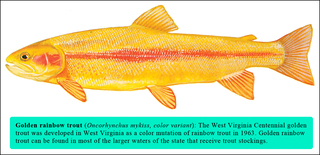 | Back to e-WV
| Back to e-WV
 The West Virginia Encyclopedia
The West Virginia Encyclopedia
 | Back to e-WV
| Back to e-WV
 The West Virginia Encyclopedia
The West Virginia Encyclopedia

The West Virginia Centennial Golden Trout received its first widespread stocking in 1963, the state’s 100th anniversary year. The fish is a color mutation of the common rainbow trout, discovered by chance and then bred for the characteristic.
Petersburg fish hatchery manager Vincent Evans noticed a yellow-mottled fingerling among the hatchery’s rainbow trout in 1955, giving it the name ‘‘Little Camouflage.’’ When Evans transferred to Spring Run hatchery later that fall, the new Petersburg manager, Chester Mace, continued a careful watch over the little fish. In late fall of 1956, the ‘‘golden’’ was spawned with a regular rainbow trout. Because of limited facilities, the eggs of this match were mixed with all of the other rainbow eggs.
Late in 1956 and early 1957, fingerlings were transferred from Petersburg to Spring Run hatchery. Within a few weeks nearly 300 fingerlings had developed a true golden color.
During subsequent years, Evans and Mace supervised the selection and spawning of brood stock, with good color quality as their primary objective. By the spring of 1963, a sufficient number of golden trout were available for stocking in West Virginia waters. They continue to be a popular part of the Division of Natural Resources trout-stocking program. Goldens have a greater tendency to seek shaded waters than normal colored rainbow and are sometimes less active. Some fishermen say they are more difficult to catch and consider them a prize, while others object to the fish as non-native and unnatural.
Written by Mike Shingleton